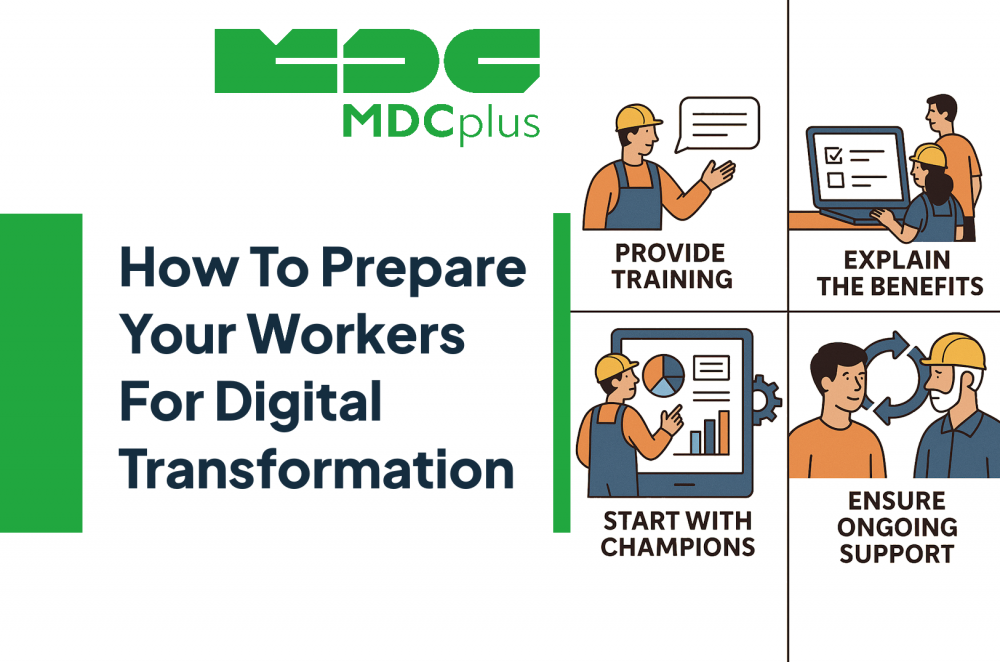How To Prepare Your Workers For Digital Transformation
Factories adopt smarter systems and data-driven processes, the success of tools like MES platforms, production tracking apps, and digital logbooks increasingly hinges on the human element. We are about to explore this and learn with you how to embrace this digital transformation.
Why Digital Adoption Isn’t Just a Tech Problem
Most modern manufacturing tools rely on some degree of human interaction. Whether it’s logging production times, marking inspections, updating status boards, or confirming quality checks, operators and supervisors are essential contributors to the data ecosystem.
When adoption falls short, the problem is rarely technical. It’s cultural. Resistance often stems from:
- Lack of understanding about how the tool benefits their work
- Fear that digital tools will be used to monitor or micromanage
- Low digital confidence or familiarity with apps and interfaces
Technology without user buy-in is like a CNC machine without a cutting tool — all potential, no performance.
Understanding the Real Barriers
Digital resistance can take many forms, and recognizing them early is critical:
- Surveillance Anxiety: Workers may perceive digital tools as a means to track or punish rather than support them.
- Skills Gap: Not all team members are equally comfortable with smartphones, tablets, or software interfaces — especially in multigenerational teams.
- Job Security Fears: Automation and digitalization can trigger concerns about redundancy or being replaced by machines.
- Poor UX: Even the most powerful tool fails when it slows workflows or adds unnecessary steps.
Core Principles to Build Workforce Readiness
Adoption starts before rollout. Successful manufacturers follow key principles that prioritize the worker experience:
Involve Early, Involve Often
Frontline teams are more likely to embrace tools they helped shape. Involve operators and supervisors in the tool selection, testing, and feedback process.
Explain the “Why”
Don’t just introduce a new tool — explain how it will help them. Show how digital inputs can reduce paperwork, streamline communication, or prevent repeat issues.
Train, Don’t Just Deploy
Hands-on training beats printed manuals every time. Pair new users with early adopters and offer bite-sized sessions tailored to specific workflows.
Design for the User
Choose tools with intuitive design, minimal clicks, and mobile-friendly interfaces. The easier it is to use, the faster it becomes part of the routine.
Rollout Strategies That Work
A smooth digital rollout isn’t about doing everything at once — it’s about building confidence and momentum.
- Start with Champions
Identify digitally curious team members and turn them into champions. Their success will influence peers more than any memo. - One Tool at a Time
Don’t overwhelm teams with a full system overhaul. Introduce one solution — like a digital checklist or shift log — and let it settle before moving on. - Establish Feedback Loops
Encourage users to speak up about what’s working and what isn’t. Iterative feedback creates a sense of ownership and reveals improvement areas. - Celebrate Adoption
Recognize teams or individuals who show progress. Public praise and visible milestones make digital wins part of the workplace culture.
Long-Term Culture Building
Sustained success requires more than good rollout. It requires a cultural shift where digital fluency becomes a core competency, not a side task.
- Embed in Onboarding
New hires should be introduced to digital systems from day one. Make tech literacy part of the skill set — like safety or machine training. - Encourage Cross-Generational Mentoring
Digital-native workers can help veterans adapt to new tools, while experienced workers offer valuable process insights that guide better tech use. - Make It Part of Growth Conversations
Discuss tool usage and digital literacy during reviews, improvement planning, and team meetings. Normalize it as part of performance development.
People Are the Real Platform
Manufacturing’s digital transformation will not be won by software alone. It will be won by people — by how well companies support, engage, and empower the human side of technology.
Digital tools are only as effective as the hands that use them and the minds that understand them. To succeed, manufacturers must invest in skills and culture, just as much as they invest in code and infrastructure.
The best tech strategy? Train your people as intentionally as you upgrade your tools.
About MDCplus
Our key features are real-time machine monitoring for swift issue resolution, power consumption tracking to promote sustainability, computerized maintenance management to reduce downtime, and vibration diagnostics for predictive maintenance. MDCplus's solutions are tailored for diverse industries, including aerospace, automotive, precision machining, and heavy industry. By delivering actionable insights and fostering seamless integration, we empower manufacturers to boost Overall Equipment Effectiveness (OEE), reduce operational costs, and achieve sustainable growth along with future planning.
Ready to increase your OEE, get clearer vision of your shop floor, and predict sustainably?
